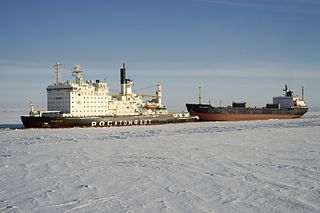
The Kara Sea is a marginal sea, separated from the Barents Sea to the west by the Kara Strait and Novaya Zemlya, and from the Laptev Sea to the east by the Severnaya Zemlya archipelago. Ultimately the Kara, Barents and Laptev Seas are all extensions of the Arctic Ocean north of Siberia.

The Northeast Passage is the shipping route between the Atlantic and Pacific Oceans, along the Arctic coasts of Norway and Russia. The western route through the islands of Canada is accordingly called the Northwest Passage (NWP).

An icebreaker is a special-purpose ship or boat designed to move and navigate through ice-covered waters, and provide safe waterways for other boats and ships. Although the term usually refers to ice-breaking ships, it may also refer to smaller vessels, such as the icebreaking boats that were once used on the canals of the United Kingdom.

A nuclear-powered icebreaker is an icebreaker with an onboard nuclear power plant that produces power for the vessel's propulsion system. Although more expensive to operate, nuclear-powered icebreakers provide a number of advantages over their diesel-powered counterparts, especially along the Northern Sea Route where heavy power demand associated with icebreaking, limited refueling infrastructure along the Siberian coast, and endurance required make diesel-powered icebreaker operations challenging. As of 2023, Russia is the only country that builds and operates nuclear-powered icebreakers, having built a number of such vessels to aid shipping along the Northern Sea Route and Russian arctic outposts since the Soviet era.

The Northern Sea Route (NSR) is a shipping route about 5,600 kilometres (3,500 mi) long, defined by Russian legislation as running from the entrances to the Novaya Zemlya straits in the west, along the Russian Arctic coast above Siberia through the Kara Sea, Laptev Sea, East Siberian Sea, and Chukchi Sea), to Cape Zhelaniya on the Bering Strait, at parallel 66 ° N and meridian of 168 ° 58′37 ″ W.

The Arktika class is a Russian class of nuclear-powered icebreakers. Formerly known as Project 10520 nuclear-powered icebreaker, they were the world's largest and most powerful icebreakers until the 2016 launch of the first Project 22220 icebreaker, also named Arktika.

Taymyr is a shallow-draft nuclear-powered icebreaker, and the first of two similar vessels. She was built in 1989 for the Soviet Union in Finland, at the Helsinki Shipyard by Wärtsilä Marine, by order of the Murmansk Shipping Company. Her sister ship is Vaygach.

The Taymyr was an icebreaking steamer of 1200 tons built for the Russian Imperial Navy at St. Petersburg in 1909. It was named after the Taymyr Peninsula.

Icebreaker Vaygach was an icebreaking steamer of moderate size built for the Russian Imperial Navy at St. Petersburg in 1909. She was named after Vaygach Island in the Russian Arctic.

Vaygach is a shallow-draught nuclear-powered icebreaker. She was built in 1989 for the Soviet Union by Wärtsilä Marine Helsinki Shipyard in Finland by order of the Murmansk Shipping Company and its KL-40 reactor was installed at the Baltic Shipyard in St. Petersburg. Her sister ship is Taymyr.
The Keiler is a river icebreaker commissioned in December 2011 to serve as the flagship of Lauenburg's Water and Shipping Authority fleet of ten icebreakers, on the Elbe River. The vessel is 33.21 metres (109.0 ft) long and 8.45 metres (27.7 ft) wide. She has a crew of four, and has sleeping and dining accommodation for operations that take longer than a single shift.
The Arctic Policy of China outlines China's approach to foreign relations with Arctic countries as well as its plans to develop infrastructure, extend military capabilities, conduct research, and excavate resources within the Arctic Circle.
Poseidon Expeditions is a provider of polar expeditions. The company was started in 1999 as a tour operator specializing in expedition cruises to the North Pole and the Russian High Arctic aboard icebreakers and ice-strengthened ships. Today Poseidon Expeditions offers expedition cruises to Antarctica, the North Pole and the Arctic destinations of Svalbard, Greenland, Franz Josef Land and Iceland.

Project 22220, also known through the Russian type size series designation LK-60Ya, is a series of Russian nuclear-powered icebreakers. The lead ship of the class, Arktika, was delivered in 2020 and surpassed the preceding Soviet-built series of nuclear-powered icebreakers as the largest and most powerful icebreaker in the world.

Arktika is a Russian nuclear-powered icebreaker built by Baltic Shipyard in Saint Petersburg. It is the lead ship of Project 22220 icebreakers and superseded the preceding class of nuclear-powered icebreakers as the largest and most powerful icebreaker ever constructed.
Sibir is a Russian Project 22220 nuclear-powered icebreaker. Built by Baltic Shipyard in Saint Petersburg, the vessel was laid down in 2015, launched in 2017, and delivered in December 2021.

Ural is a Russian Project 22220 nuclear-powered icebreaker. Built by Baltic Shipyard in Saint Petersburg, the vessel was laid down in 2016, launched in 2019 and delivered in 2022.
Yakutiya is a Russian Project 22220 nuclear-powered icebreaker currently under construction at Baltic Shipyard in Saint Petersburg.
Chukotka is a Russian Project 22220 nuclear-powered icebreaker currently under construction at Baltic Shipyard in Saint Petersburg.











